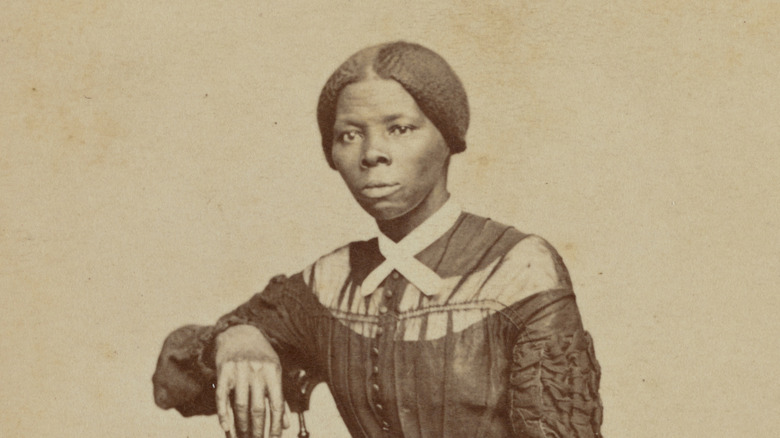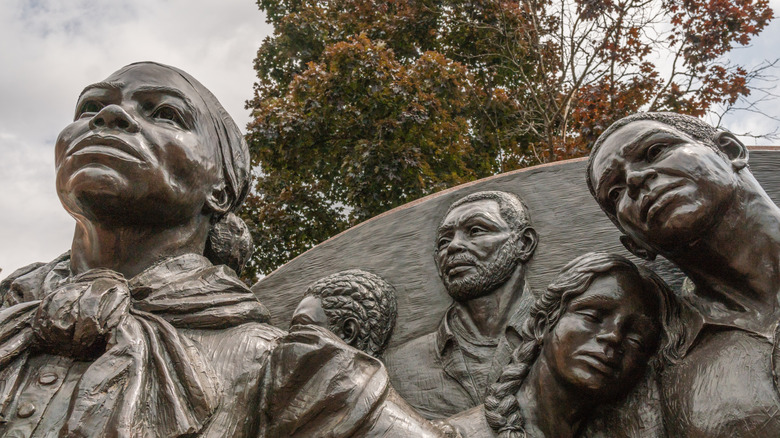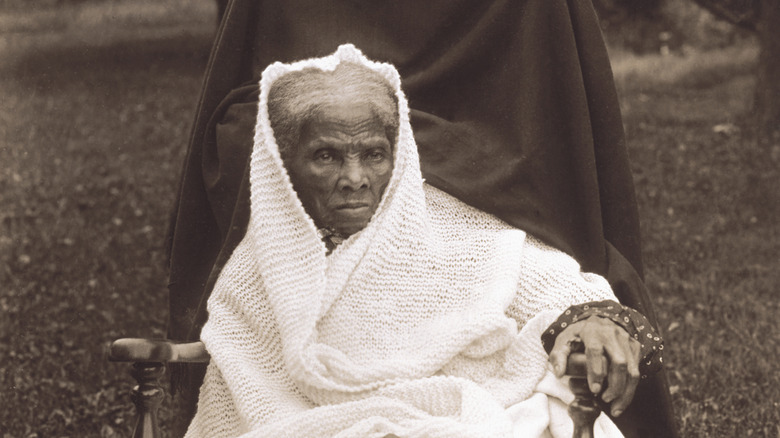The Tragic Injury Harriet Tubman Never Recovered From
It was circa 1836 when a farmer named Barrett followed one of the people he enslaved to the village store one autumn evening. The man was supposed to be working, but he'd left without permission. A 13-year-old girl named Araminta "Minty" Ross followed Barrett, who caught up to the enslaved man at the store and declared he'd earned a whipping. He called on Ross and others nearby to help tie the man up, and after the man ran away, Ross blocked the doorway in an effort to slow down Barrett's chase.
Barrett then picked up a two-pound weight that was sitting nearby and chucked it at the running man. Instead, it hit Ross, who would later go down in history as Harriet Tubman after changing her name when she married John Tubman in 1944. Her mother, also named Harriet, nursed Tubman back to health after the weight "struck [her] a stunning blow on the head," per Sarah Bradford's 1897 book "Harriet: The Moses of her People."
Despite her injury, which led to lifelong issues, Tubman went on to help some 70 enslaved people escape to freedom via the Underground Railroad, per the Harriet Tubman Byway. The name detracts from the reality of what she risked, though. Tubman, who escaped a Maryland plantation and made her way to Philadelphia, returned to the South at least 13 times on foot to escort other enslaved people north to freedom. She did all that and more while dealing with the aftermath of what today would likely be considered a traumatic brain injury.
Harriet Tubman suffered from 'sleeping spells'
It's impossible to know the extent of Harriet Tubman's injury since as an enslaved person, she was not seen by a doctor. Some sources say she developed narcolepsy, others claim it was epileptic seizures. What is known is that it was unclear whether the teenager would live or die, and she was sent to stay with her mother for the months it took her to be well enough to work again. Though her body recovered, she was never the same, suffering from "sleeping spells," as she called them, for the rest of her long life (via the National Women's History Museum).
Narcolepsy is a condition that causes people to get so drowsy during the day they simply fall asleep in the middle of doing things. The sleep may be just a brief few minutes or it can last for as long as 30 minutes. Epilepsy causes seizures, and these can look different for everyone depending on which part of the brain is misfiring. In Tubman's case, she seemed to lose consciousness for short durations. She also lived with terrible headaches, a droopy left eye, and a scar from where the weight bashed her skull.
During her "spells," Tubman also reported having what she perceived as visions from God. Those around Tubman also attributed her visions as proof of her religious piety. Science has another explanation though — hallucinations are a symptom of narcolepsy.
Despite her brain injury, Harriet Tubman helped others her entire life
Though many accepted Harriet Tubman's sleeping spells and visions as part of her connection to God, it was also likely somewhat unsettling when she would nod off while leading enslaved people to freedom. One account was shared in the Journal of General Internal Medicine: "Lethargy often came upon her with no notice, and during her rescues she would occasionally drop off to sleep, jeopardizing the safety of her parties of runaways. But she never 'lost a passenger,' and her friends and family marveled at her ability to run the 'gauntlet of the most difficult parts of the Southern country.'"
During her visions, Tubman described hearing music, leaving her body, and seeing other places, including ethereal worlds filled with spirits. According to the National Women's History Museum, one such experience even made her confident she would find her way to freedom — which, of course, she did. Regardless of the cause of her visions, Tubman trusted in them.
Her brain injury affected her in unusual ways, but even today, there is no cure for narcolepsy or epilepsy. And Tubman survived many more perilous situations as she traveled back and forth between the North and South to help enslaved people escape. She continued her work with the Union Army during the Civil War, helping as a nurse and even being credited as the first woman to "plan and lead a military raid" (per the National Women's History Museum). She later opened the Home for the Aged, all while living with the long-term effects of the violent action of an enraged farmer. Tubman died in 1913 at 91 years old and is buried in Auburn, New York.


